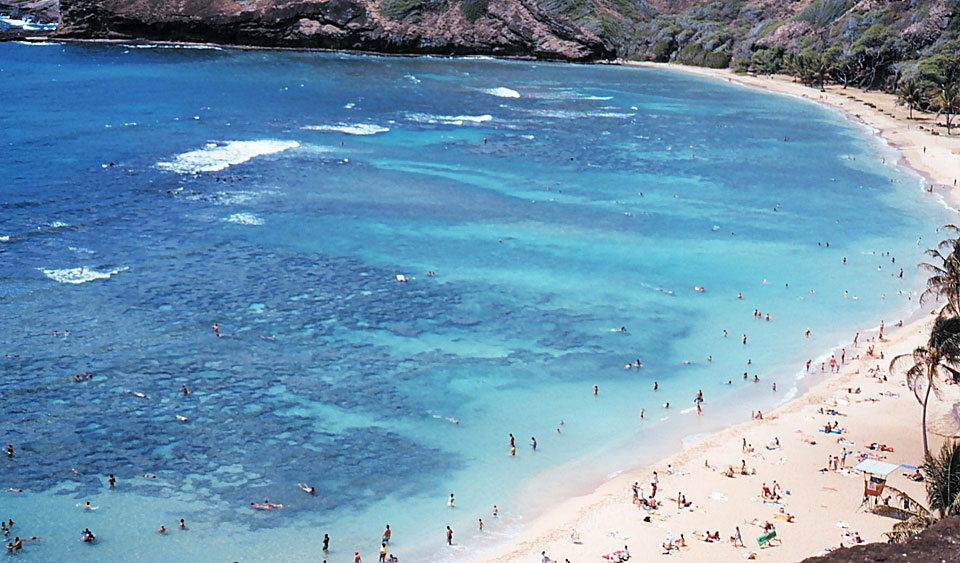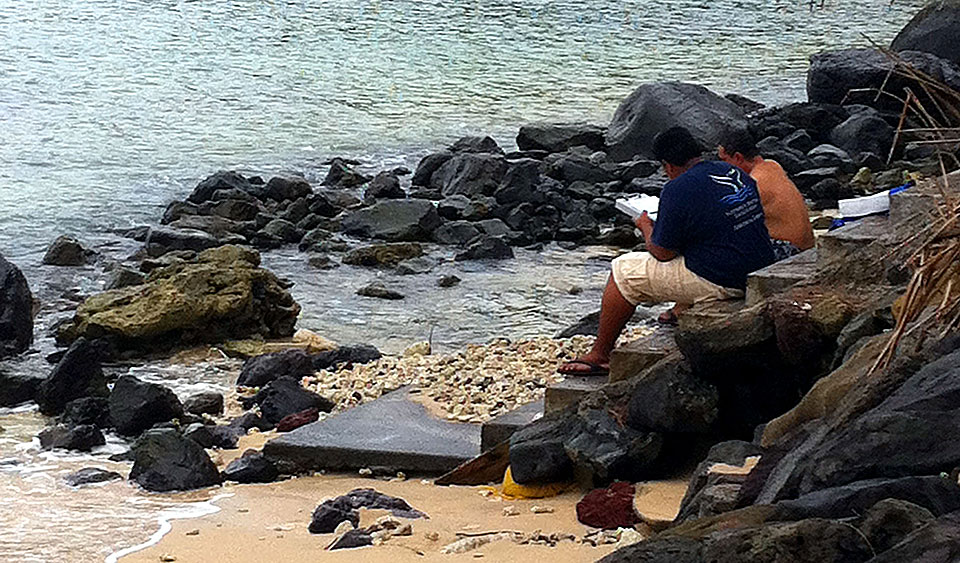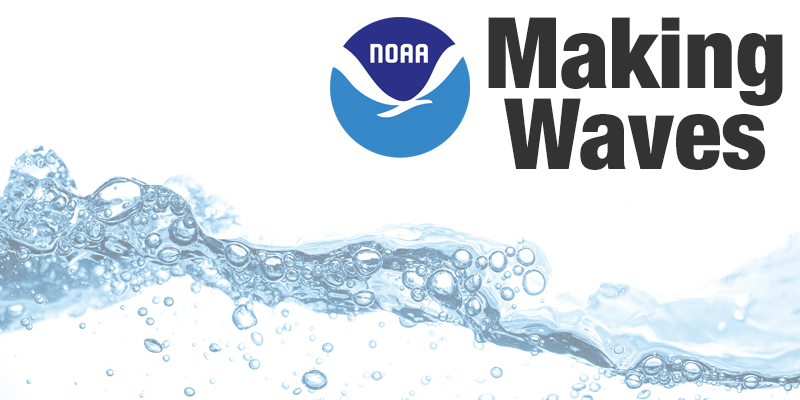Connecting the Dots Between Corals and Humans
Making Waves: Episode 135
Coral reefs are under intense pressure from climate change, pollution, and unsustainable use. So what can we do about it? To answer that question, we need to better understand the main threat to our reefs. Humans.

NOAA closely monitors coral health near U.S. states and territories with high densities of coral reefs. Part of this long-term scientific study involves better understanding the humans who live near and rely upon these reefs.
Listen to the Episode:
Transcript
[HOST] This is Making Waves from NOAA's National Ocean Service. I'm Troy Kitch. Coral reefs are the largest biological structures on the planet. It's hard to believe that structures so large can be created by tiny little coral polyps over thousands of years. And you might think that since corals have been around for tens of thousands of years, that they'll be around for thousands of years to come. But that's not necessarily the case. Scientists are finding that corals are in serious trouble. And there's a global effort underway to do something about it.
[HOST] Today we're going to talk about the U.S. component of this global effort. It's called the NOAA national coral reef monitoring program. And with this program, NOAA scientists are closely studying reefs across all of our national coral reef jurisdictions—those are the places near our states and territories with high densities of reefs. Now, this monitoring effort is pretty complicated, but what you need to know is that it's about scientists delivering high-quality data so they can provide that to people who need it—and that helps us make better decisions about protecting and conserving our reefs.

A NOAA surveyor interviews an American Samoan resident. Interviews with local residents are a key component of an effort to understand the human side of coral reef conservation and management. NOAA's socioeconomic studies examine residents' participation in reef-related activities as well as their knowledge, attitudes, and perceptions of coral reefs and their management. Image courtesy of Stacey Kilarski.
[HOST] NOAA scientists are monitoring corals, coral ecosystems, and how climate is affecting corals … but they're also gathering information about humans. And that's our topic for today. We're going to look at socioeconomics, the newest branch of NOAA's national coral reef monitoring program. We're joined on the phone by Maria Dillard and Peter Edwards, NOAA social scientists. So why are corals getting so much attention, Peter ?
[Peter Edwards] "Corals take up a very small slice in terms of physical surface area on the planet, but because they're such wonderful storehouses of biodiversity, they actually contribute a significant amount. So many of the world's fisheries either directly depend on coral reefs as habitat or interact very closely with coral reefs, because coral reefs not only provide fisheries for humans, but they also provide smaller animals and plants for other larger animals, for example, fish such as tuna, that humans depend on. The other reason why they're so special and I think why they're getting all this attention at this time: in the face of global climate change and global warming, we're having warmer oceans and this is also leading to more acidic oceans conditions — a term that's called ocean acidification — because corals are by nature made of limestone, a more acidic ocean means that we'll have less corals. That means the corals are potentially slowly dissolving in this increasingly acidic water. In addition to that, when we have these spikes in temperature, we have bleaching events where the water gets so warm that the corals expel their natural pigments. Sometimes they recover and sometimes they don't. But the point is, you can use the example of corals as a 'canary in the coalmine' as a signal of when things are not going so well."
[HOST] Just to add some extra context for our listeners: in the Fall of 2015, NOAA coral scientists announced that we've entered a period of global coral bleaching because many spots in the ocean are experiencing record ocean temperatures. As Peter said, the big problem with bleaching is that coral expel the symbiotic algae living in their tissues. Without this algae, the coral loses its major food source and is more susceptible to disease. (pause) Maria, tell me a bit about how social and economic research fits into the coral reef monitoring program.
[Maria Dillard] "The National Coral Reef Monitoring Program has these four components to it and two are kind of grouped under biological, and that's the benthic and the fish, and then there's a climate component. And then the final component that's the new one is socioeconomics and that's the piece that Peter and I are responsible for and is really the new and exciting piece of this monitoring program that's been set up for the U.S. coral reef jurisdictions."
[HOST] OK, let me see if have this right. Biologists and other physical scientists are studying benthic, or sea floor, coral habitats along with the fish that depend on corals. Climate scientists are studying climate change and its impacts to corals. And your team is studying social and economic factors related to the health of our coral reefs.
[Maria Dillard] "Yes. The socioeconomic component is set up to look at the connections between people and coral reefs. We're looking at both sides of this coin. We want to know about the positive connections — the ways in which people depend upon reefs, value and use reefs — and also, look at some of the negatives as well. So, what are the ways that we know human population and development are impacting coral reefs in negative ways."
[Peter Edwards] "Our program does a lot of different things, but in many ways we're grouped into three big areas. Fishing impacts on corals, on land-based sources of pollution, and climate impacts. Based on those categories, you can see that there are human elements that are sprinkled across all those three."
And you're trying to understand these human elements. Could you talk a bit more about why there's a need to better understand this connection?
[Peter Edwards] "So the physical changes that you may be observing in our coral reef systems may be directly or indirectly linked to people. We're very good in NOAA as an agency monitoring some of these biological and physical changes over time. But it's important for us to make this connection because we could be tracking changes, and if we're not linking them to people's behavior, we may just be ending up watching things change."
[Peter Edwards] "People depend on the reefs and also people get value from the reefs. Sometimes people may not necessarily be aware of the connection that they have with the reefs, so understanding the level of awareness is also important because it can then help managers and conservation agencies such as NOAA to provide information and to craft better ways to highlight these connections between people and reefs. So understanding the connection of people's perceptions is important, understanding how they're participating in the reef resources, and how these activities may be stressing or impacting these reefs, or there may be beneficial behaviors that people are conducting and it's important to know this so that we can share these stories with other people."
Maria, what kind of questions are you trying to answer with this research?
[Maria Dillard] "We are very interested in understanding the current status of human knowledge, of our attitudes and perceptions about coral reefs, but also the marine environment. We want to understand how people think about the marine environment, how they understand the issues that are of concern at the moment, and how they perceive themselves in relation to these things. Also, we're really interested in understanding how humans use the environment. How they interact with coral reefs, how they interact with the ocean, and how dependent they are. So one of the big questions for social scientists is to get a really strong sense of the reliance on the resources. We want to understand how communities are dependent on the resources. And we understand also that not all communities are. Not all communities are surviving based on the fish that they're catching or on the industries that are based on the marine environment. But there's a lot to get to beyond some of that initial level of people who are subsisting based on resources, to what are the other connections that populations have. So what are the cultural connections people have to the coral reefs and the environment around them? What are the social values that come into play ? How does the environment figure in to important festivals and cultural events that people have as a gathering space for community events and parties. "
[HOST] So what has your research turned up so far?
[Maria Dillard] "In all of our jurisdictions, we are seeing an overwhelming positive response towards a variety of management options that are being taken or that are potential management strategies to deal with protecting the coral reef ecosystem and the marine environment. Managers and politicians and others working on these issues always feel like people respond negatively to areas of closure or reduced access, or to zoning a space so that only particular activities can take place in certain areas, to the existence of marine protected areas. And, overall, we're finding that the general population actually feels pretty positively about these things. One thing that we're noticing is that the more people favor different management options, the more familiar with threats to reefs they are. So one reason that we might be seeing a very strong connection between people being in support of management may be that they're very aware of the threats to coral reefs and they're concerned. This is something that we hope is true and that we want to investigate further."
[HOST] Are there any other patterns that you've discovered?
[Maria Dillard] "One thing that we are noticing that is really interesting is that the longer time people have lived in a jurisdiction, the more they have negative perceptions of the change in marine resources over time. When we ask questions about how the condition of ocean water quality has changed in the last ten years, or how the coral reefs have changed ten years, they're tending to respond more negatively, so they see a decline as opposed to an improvement during this time period. And it's very connected to the amount of time they've lived in the place. One explanation to this is that people who have lived in a place longer have observed the better state, they remember when the coral reefs looked healthier, they remember when the water was cleaner, they remember when there were more fish, and they are seeing a decline over time. So that's another example of something that we're noticing."
[HOST] Once you've gathered up all of these lessons learned about how people feel about corals, and how they interact with the ocean and reefs, what do you do with this data? How is it tied back in to the coral reef monitoring program?
[Peter Edwards] "I think because this is the first time we're systematically including socioeconomic monitoring as part of the coral reef monitoring program, we are still working on ways on how to best incorporate this information. We're speaking to our colleagues and thinking through potential research questions and ways that this information can be utilized. One example that we've been discussing is making this link between the public's perception of coral reef resources and what scientists are finding and seeing how close or how far the public is from what the scientific findings suggest. So this is a rough and crude way of seeing how this information can be integrated into the biology and climate components. One of the key purposes of this program is to improve management, so getting the human dimension information and sharing that with our colleagues, that will help them in their management of these resources, and also perhaps assist them in transmitting the scientific information to the public in a way that the public can understand it."
[Maria Dillard] "I think the question of how to integrate socioeconomic, biological, climate data together to answer questions is really the holy grail for many of us and represents an area that lots and lots of people are working really hard on at the moment, because we know intuitively that these things are connected, but we don't have tons and tons of research to explain how and in what ways specifically, and what are the consequences of this connection and so I think this is one of the big areas that we expect the national coral reef monitoring program to be able to influence."
[HOST] I think we've covered a lot of the nuts and bolts about your research, but I also want to ask you to talk about your work on a more personal level. I'm curious about what drives you to do this type of work and why you care about it. Peter, do you want to start?
[Peter Edwards] "You know, my previous work was as a marine scientist doing biological monitoring and watching some of these ecosystems either continue to decline or kind of fluctuate between doing OK and not doing OK, and realizing that there's this link of the people and the condition of the environment. So the passion is trying to be a conduit in trying to make this link between observational research … you know, numbers of fish, amount of live coral cover that we're seeing, amount of bleaching events … and making that link more direct to the people who are impacted and who might suffer from these changes and also some of the people who may be causing these things to happen. And having a better understanding of that linkage so that this information can be included into our management and our planning and decision-making. We really have to make sure that the information is connecting with the people that it's supposed to be benefiting and I think that's kind of my underlying driver. Sometimes you have these scientists in various disciplines, not only in biophysical sciences, you know, they do good work, very comprehensive work, everything you want to know about these systems and they say, once they publish it, people should just know and understand that that's the way it is. But in reality, it doesn't work like that. We have to be interfacing between these different audiences. Some of these audiences may be more technical and some of these audiences may be the fisherman, or the fisherwomen, or children and young people who might be interacting with these systems. And so making that link between the biological and the social and the economic is, I guess, kind of one of my underlying drivers for why I do what I'm doing."
[HOST] Maria?
[Maria Dillard] "We work in a lot of places where people have great needs. They would like to develop their economies further. I don't think that's a wrong wish or desire. They want to have more. They want their children to have more. I can understand that and I think trying to figure out how to help support that in a balanced way in relation to the health of the environment where they live is really, really important. I think it helps to have a bit of an understanding of the needs and the motivations that are driving people. There are a lot of people who work in conservation who feel that the problem is people and they're quick to say 'if we got rid of all the people, we'd be fine.' That may be true, but it's not very realistic and it's also not really helpful. I think we have a responsibility to think about this real challenge and this real kind of push and pull that we see between people wanting better lives and they also need a healthy environment. And we have to make sure people understand that they won't be better off if they destroy the environment and these things really have to be worked out together. So that's where I come from with this work, and one of the reasons why I think this particular research is so important and interesting and exciting, because we're really bringing those pieces together. For this purpose of understanding how this whole thing works: how the push and pull of society and the environment all kind of come together and either works well or it doesn't. And we have a real opportunity to try and shape how it goes forward."
[HOST] Thanks to Maria Dillard and Peter Edwards for joining us for this episode. Maria is a social scientist with NOAA's National Centers for Coastal Ocean Science. Peter is a natural resource economist and social science coordinator with NOAA's Coral Reef Conservation Program. Head to our website at oceanservice.noaa.gov/podcast for the transcript of this interview along with lots of links to more resources if you want to learn more.
This is Making Waves from NOAA's National Ocean Service. Until next time.

From corals to coastal science, catch the current of the ocean with our audio and video podcast, Making Waves.
Subscribe to Feed | Subscribe in iTunes